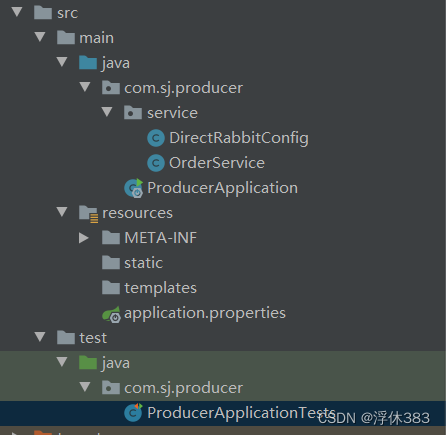目录
(2)配置文件(.properties)消费者生产者使用不同的端口
一.创建一个SpringBoot项目
二.导入依赖
spring-boot-starter-parent在3.0以下
<parent>
<groupId>org.springframework.boot</groupId>
<artifactId>spring-boot-starter-parent</artifactId>
<version>2.4.2</version>
<relativePath/> <!-- lookup parent from repository -->
</parent><dependencies>
<dependency>
<groupId>org.springframework.boot</groupId>
<artifactId>spring-boot-starter-web</artifactId>
</dependency>
<dependency>
<groupId>org.springframework.boot</groupId>
<artifactId>spring-boot-starter-amqp</artifactId>
</dependency>
<dependency>
<groupId>org.springframework.boot</groupId>
<artifactId>spring-boot-starter-web</artifactId>
</dependency>
<dependency>
<groupId>org.springframework.boot</groupId>
<artifactId>spring-boot-starter-web-services</artifactId>
</dependency>
<dependency>
<groupId>org.springframework.boot</groupId>
<artifactId>spring-boot-devtools</artifactId>
<scope>runtime</scope>
<optional>true</optional>
</dependency>
<dependency>
<groupId>org.springframework.boot</groupId>
<artifactId>spring-boot-starter-test</artifactId>
<scope>test</scope>
</dependency>
</dependencies>
三.RabbitMQ的三种模式
1.fanout
(1)目录结构


(2)配置文件(.properties)消费者生产者使用不同的端口
server.port=8081
spring.rabbitmq.host=安装RabbitMQ的IP地址
spring.rabbitmq.username=admin
spring.rabbitmq.password=admin
spring.rabbitmq.port=5672
spring.rabbitmq.virtual-host=/
(3)生产者代码
DirectRabbitConfig.class
package com.sj.producer.service;
import org.springframework.amqp.core.*;
import org.springframework.context.annotation.Bean;
import org.springframework.context.annotation.Configuration;
@Configuration
public class DirectRabbitConfig {
//队列 起名:TestDirectQueue
@Bean
public Queue emailQueue() {
// durable:是否持久化,默认是false,持久化队列:会被存储在磁盘上,当消息代理重启时仍然存在,暂存队列:当前连接有效
// exclusive:默认也是false,只能被当前创建的连接使用,而且当连接关闭后队列即被删除。此参考优先级高于durable
// autoDelete:是否自动删除,当没有生产者或者消费者使用此队列,该队列会自动删除。
// return new Queue("TestDirectQueue",true,true,false);
//一般设置一下队列的持久化就好,其余两个就是默认false
return new Queue("email.fanout.queue", true);
}
@Bean
public Queue smsQueue() {
// durable:是否持久化,默认是false,持久化队列:会被存储在磁盘上,当消息代理重启时仍然存在,暂存队列:当前连接有效
// exclusive:默认也是false,只能被当前创建的连接使用,而且当连接关闭后队列即被删除。此参考优先级高于durable
// autoDelete:是否自动删除,当没有生产者或者消费者使用此队列,该队列会自动删除。
// return new Queue("TestDirectQueue",true,true,false);
//一般设置一下队列的持久化就好,其余两个就是默认false
return new Queue("sms.fanout.queue", true);
}
@Bean
public Queue weixinQueue() {
// durable:是否持久化,默认是false,持久化队列:会被存储在磁盘上,当消息代理重启时仍然存在,暂存队列:当前连接有效
// exclusive:默认也是false,只能被当前创建的连接使用,而且当连接关闭后队列即被删除。此参考优先级高于durable
// autoDelete:是否自动删除,当没有生产者或者消费者使用此队列,该队列会自动删除。
// return new Queue("TestDirectQueue",true,true,false);
//一般设置一下队列的持久化就好,其余两个就是默认false
return new Queue("weixin.fanout.queue", true);
}
//Direct交换机 起名:TestDirectExchange
@Bean
public FanoutExchange fanoutOrderExchange() {
// return new DirectExchange("TestDirectExchange",true,true);
return new FanoutExchange("fanout_order_exchange", true, false);
}
//绑定 将队列和交换机绑定, 并设置用于匹配键:TestDirectRouting
@Bean
public Binding bindingDirect1() {
return BindingBuilder.bind(weixinQueue()).to(fanoutOrderExchange());
}
@Bean
public Binding bindingDirect2() {
return BindingBuilder.bind(smsQueue()).to(fanoutOrderExchange());
}
@Bean
public Binding bindingDirect3() {
return BindingBuilder.bind(emailQueue()).to(fanoutOrderExchange());
}
}
OrderService.class
package com.sj.producer.service;
import org.springframework.amqp.rabbit.core.RabbitTemplate;
import org.springframework.beans.factory.annotation.Autowired;
import org.springframework.stereotype.Component;
import java.util.UUID;
/**
* @author: 学相伴-飞哥
* @description: OrderService
* @Date : 2021/3/4
*/
@Component
public class OrderService {
@Autowired
private RabbitTemplate rabbitTemplate;
// 1: 定义交换机
private String exchangeName = "fanout_order_exchange";
// 2: 路由key
private String routeKey = "";
public void makeOrder(Long userId, Long productId, int num) {
// 1: 模拟用户下单
String orderNumer = UUID.randomUUID().toString();
// 2: 根据商品id productId 去查询商品的库存
// int numstore = productSerivce.getProductNum(productId);
// 3:判断库存是否充足
// if(num > numstore ){ return "商品库存不足..."; }
// 4: 下单逻辑
// orderService.saveOrder(order);
// 5: 下单成功要扣减库存
// 6: 下单完成以后
System.out.println("用户 " + userId + ",订单编号是:" + orderNumer);
// 发送订单信息给RabbitMQ fanout
rabbitTemplate.convertAndSend(exchangeName, routeKey, orderNumer);
}
}
测试类ProducerApplicationTests.class
package com.sj.producer;
import com.sj.producer.service.OrderService;
import org.junit.jupiter.api.Test;
import org.springframework.beans.factory.annotation.Autowired;
import org.springframework.boot.test.context.SpringBootTest;
@SpringBootTest
class ProducerApplicationTests {
@Autowired
OrderService orderService;
@Test
void contextLoads() throws InterruptedException {
for (int i = 0; i < 10; i++) {
Thread.sleep(1000);
Long userId = 100L + i;
Long productId = 10001L + i;
int num = 10;
orderService.makeOrder(userId, productId, num);
}
}
}
(4)消费者代码
EmailService.class
package com.sj.consumer.service;
import org.springframework.amqp.core.ExchangeTypes;
import org.springframework.amqp.rabbit.annotation.*;
import org.springframework.stereotype.Component;
// bindings其实就是用来确定队列和交换机绑定关系
@RabbitListener(bindings =@QueueBinding(
// email.fanout.queue 是队列名字,这个名字你可以自定随便定义。
value = @Queue(value = "email.fanout.queue",autoDelete = "false"),
// order.fanout 交换机的名字 必须和生产者保持一致
exchange = @Exchange(value = "fanout_order_exchange",
// 这里是确定的rabbitmq模式是:fanout 是以广播模式 、 发布订阅模式
type = ExchangeTypes.FANOUT)
))
@Component
public class EmailService {
// @RabbitHandler 代表此方法是一个消息接收的方法。该不要有返回值
@RabbitHandler
public void messagerevice(String message){
// 此处省略发邮件的逻辑
System.out.println("email-------------->" + message);
}
}
SMSService.class
package com.sj.consumer.service;
import org.springframework.amqp.core.ExchangeTypes;
import org.springframework.amqp.rabbit.annotation.*;
import org.springframework.stereotype.Component;
// bindings其实就是用来确定队列和交换机绑定关系
@RabbitListener(bindings =@QueueBinding(
// email.fanout.queue 是队列名字,这个名字你可以自定随便定义。
value = @Queue(value = "sms.fanout.queue",autoDelete = "false"),
// order.fanout 交换机的名字 必须和生产者保持一致
exchange = @Exchange(value = "fanout_order_exchange",
// 这里是确定的rabbitmq模式是:fanout 是以广播模式 、 发布订阅模式
type = ExchangeTypes.FANOUT)
))
@Component
public class SMSService {
// @RabbitHandler 代表此方法是一个消息接收的方法。该不要有返回值
@RabbitHandler
public void messagerevice(String message){
// 此处省略发邮件的逻辑
System.out.println("sms-------------->" + message);
}
}
WeixinService.class
package com.sj.consumer.service;
import org.springframework.amqp.core.ExchangeTypes;
import org.springframework.amqp.rabbit.annotation.*;
import org.springframework.stereotype.Component;
// bindings其实就是用来确定队列和交换机绑定关系
@RabbitListener(bindings =@QueueBinding(
// email.fanout.queue 是队列名字,这个名字你可以自定随便定义。
value = @Queue(value = "weixin.fanout.queue",autoDelete = "false"),
// order.fanout 交换机的名字 必须和生产者保持一致
exchange = @Exchange(value = "fanout_order_exchange",
// 这里是确定的rabbitmq模式是:fanout 是以广播模式 、 发布订阅模式
type = ExchangeTypes.FANOUT)
))
@Component
public class WeixinService {
// @RabbitHandler 代表此方法是一个消息接收的方法。该不要有返回值
@RabbitHandler
public void messagerevice(String message){
// 此处省略发邮件的逻辑
System.out.println("weixin-------------->" + message);
}
}
2.direct
(1)生产者
基本代码与fanout差不错,修改部分代码
//1.OrderService.class
// private String routeKey = "";
//改为
private String routeKey = "routekey的值,与消费者对应";
DirectRabbitConfig.class改为
package com.sj.producer.service;
import org.springframework.amqp.core.*;
import org.springframework.context.annotation.Bean;
import org.springframework.context.annotation.Configuration;
@Configuration
public class DirectRabbitConfig {
//队列 起名:TestDirectQueue
@Bean
public Queue emailQueue() {
// durable:是否持久化,默认是false,持久化队列:会被存储在磁盘上,当消息代理重启时仍然存在,暂存队列:当前连接有效
// exclusive:默认也是false,只能被当前创建的连接使用,而且当连接关闭后队列即被删除。此参考优先级高于durable
// autoDelete:是否自动删除,当没有生产者或者消费者使用此队列,该队列会自动删除。
// return new Queue("TestDirectQueue",true,true,false);
//一般设置一下队列的持久化就好,其余两个就是默认false
return new Queue("email.fanout.queue", true);
}
@Bean
public Queue smsQueue() {
// durable:是否持久化,默认是false,持久化队列:会被存储在磁盘上,当消息代理重启时仍然存在,暂存队列:当前连接有效
// exclusive:默认也是false,只能被当前创建的连接使用,而且当连接关闭后队列即被删除。此参考优先级高于durable
// autoDelete:是否自动删除,当没有生产者或者消费者使用此队列,该队列会自动删除。
// return new Queue("TestDirectQueue",true,true,false);
//一般设置一下队列的持久化就好,其余两个就是默认false
return new Queue("sms.fanout.queue", true);
}
@Bean
public Queue weixinQueue() {
// durable:是否持久化,默认是false,持久化队列:会被存储在磁盘上,当消息代理重启时仍然存在,暂存队列:当前连接有效
// exclusive:默认也是false,只能被当前创建的连接使用,而且当连接关闭后队列即被删除。此参考优先级高于durable
// autoDelete:是否自动删除,当没有生产者或者消费者使用此队列,该队列会自动删除。
// return new Queue("TestDirectQueue",true,true,false);
//一般设置一下队列的持久化就好,其余两个就是默认false
return new Queue("weixin.fanout.queue", true);
}
//Direct交换机 起名:TestDirectExchange
@Bean
public DirectExchange fanoutOrderExchange() {
return new DirectExchange("TestDirectExchange",true,true);
// return new FanoutExchange("fanout_order_exchange", true, false);
}
//绑定 将队列和交换机绑定, 并设置用于匹配键:TestDirectRouting
@Bean
public Binding bindingDirect1() {
return BindingBuilder.bind(weixinQueue()).to(fanoutOrderExchange()).with("");
}
@Bean
public Binding bindingDirect2() {
return BindingBuilder.bind(smsQueue()).to(fanoutOrderExchange()).with("");
}
@Bean
public Binding bindingDirect3() {
return BindingBuilder.bind(emailQueue()).to(fanoutOrderExchange()).with("");
}
}
(2)消费者
*service.class
@RabbitListener(bindings =@QueueBinding(
// email.fanout.queue 是队列名字,这个名字你可以自定随便定义。
value = @Queue(value = "sms.fanout.queue",autoDelete = "false"),
// order.fanout 交换机的名字 必须和生产者保持一致
exchange = @Exchange(value = "fanout_order_exchange",
// 这里是确定的rabbitmq模式是:fanout 是以广播模式 、 发布订阅模式
type = ExchangeTypes.FANOUT),
))
改为
@RabbitListener(bindings =@QueueBinding(
// email.fanout.queue 是队列名字,这个名字你可以自定随便定义。
value = @Queue(value = "sms.fanout.queue",autoDelete = "false"),
// order.fanout 交换机的名字 必须和生产者保持一致
exchange = @Exchange(value = "fanout_order_exchange",
// 这里是确定的rabbitmq模式是:fanout 是以广播模式 、 发布订阅模式
type = ExchangeTypes.DIRECT),
key = "与生产者对应的routekey"
))
3.topic
(1)生产者
代码与direct模式差不多,修改部分如下
DirectRabbitConfig.class
@Bean
public TopicExchange fanoutOrderExchange() {
return new TopicExchange("TestDirectExchange",true,true);
}
OrderService.class
private String routeKey = "使用单词用“.”隔开";
(2)消费者
*service.class
type = ExchangeTypes.TOPIC
key = "通配符组成的字符串"
三.注意
1.使用不同的模式尽量使用不同的交换机名称和队列名称
2.使用相同的交换机名称和队列名称启动前在web控制台删除旧模式创建的交换机和队列
版权声明:本文为qq_55946937原创文章,遵循 CC 4.0 BY-SA 版权协议,转载请附上原文出处链接和本声明。